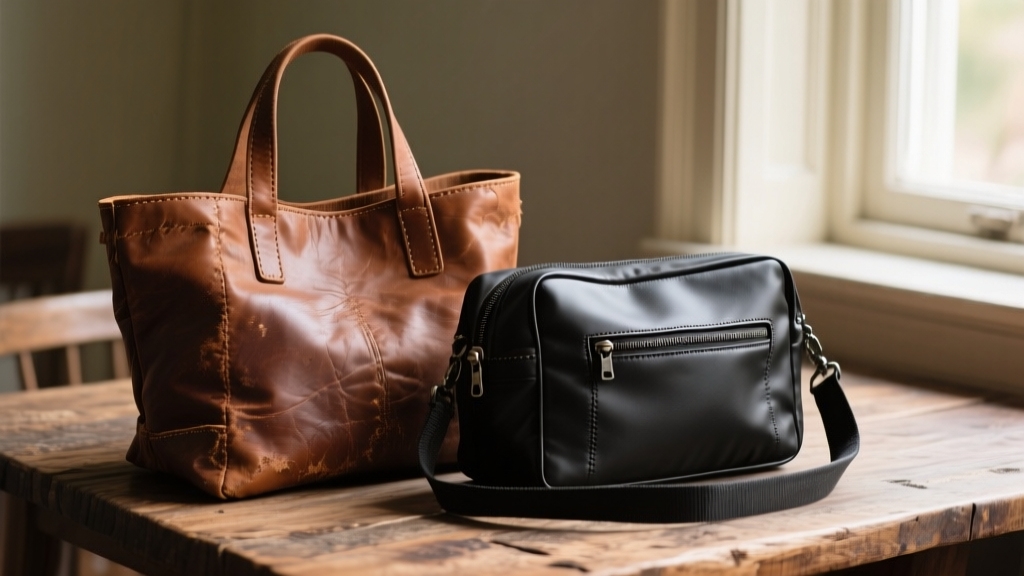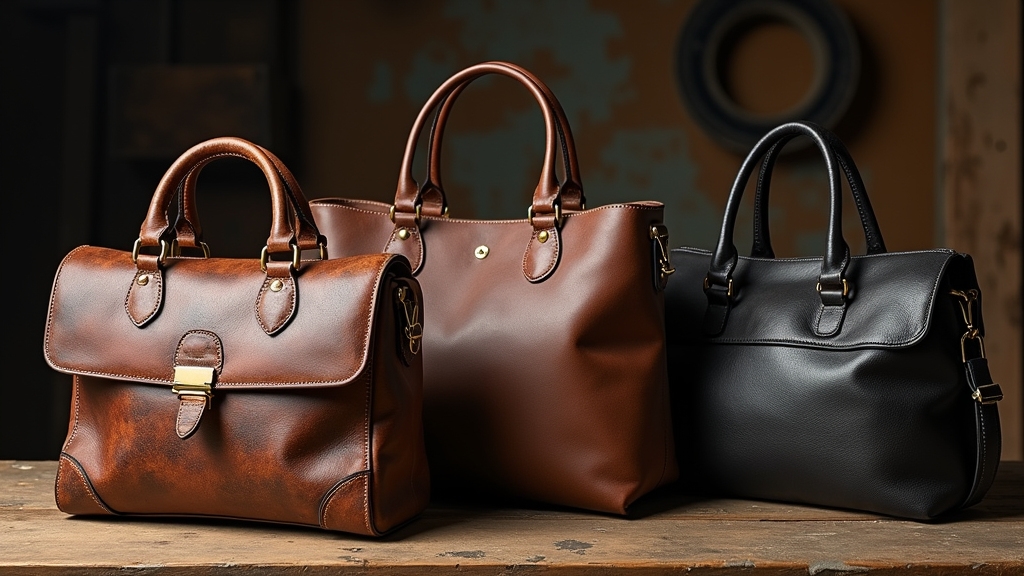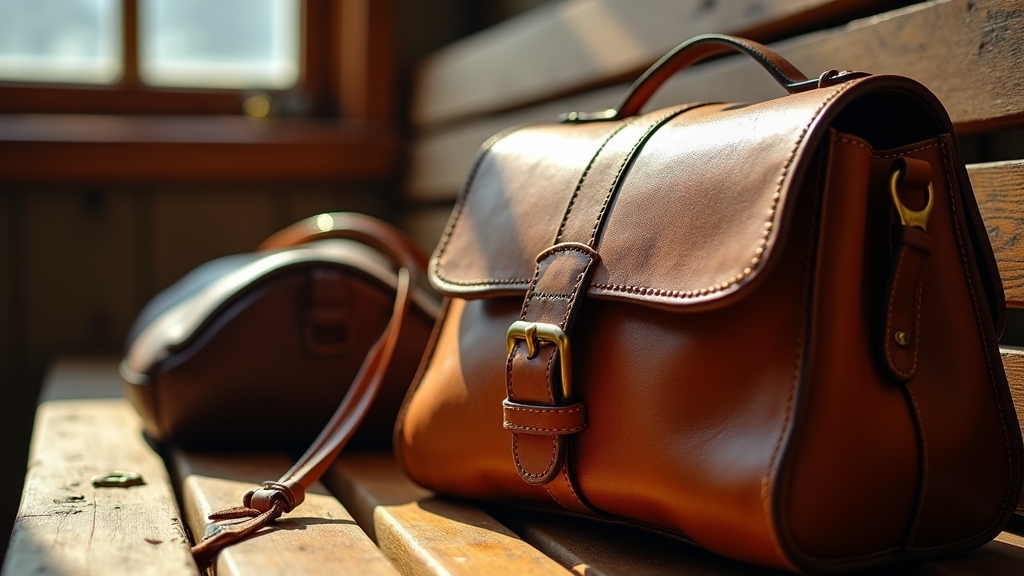
You’ll find that leather handbags outlast synthetic and vegan options thanks to their superior material strength and resilience. Full-grain or vegetable-tanned leather offers tear resistance and develops a unique patina with use, unlike synthetic fabrics that tend to crack or peel within a few years.
Proper tanning and maintenance preserve leather’s durability and aesthetic appeal far beyond most alternatives. Understanding these factors reveals why leather remains the go-to choice for lasting quality and luxury.
Key Takeaways
- Full-grain leather handbags typically last over 20 years, significantly outlasting synthetic and vegan alternatives that last 3–5 years.
- Vegetable-tanned and oil-tanned leathers offer superior tear resistance and longevity compared to most synthetic coatings.
- Leather develops a durable patina and resists tearing, while synthetic and vegan materials often crack, peel, or fade.
- Proper leather maintenance, including conditioning and waterproofing, extends handbag durability beyond synthetic counterparts.
- High-end brands prefer leather for its strength and aging qualities, highlighting its superior physical robustness over synthetics.
Leather vs Synthetic vs Vegan: The Complete Durability Breakdown
| Material Type | Average Lifespan | Durability Rating | Key Strengths | Main Weaknesses | Best For |
|---|---|---|---|---|---|
| Full-Grain Leather | 15-25+ years | ⭐⭐⭐⭐⭐ | Superior tear resistance, develops rich patina, breathable structure | Higher cost, requires maintenance | Long-term investment, luxury appeal |
| Top-Grain Leather | 10-15 years | ⭐⭐⭐⭐ | Good durability, softer texture, maintains shape well | Less character development than full-grain | Balanced quality and price |
| Chrome-Tanned Leather | 8-12 years | ⭐⭐⭐⭐ | Water-resistant, flexible, consistent quality | Less aging character, chemical processing | Everyday use, weather resistance |
| PU Synthetic Leather | 2-4 years | ⭐⭐ | Low maintenance, water-resistant, affordable | Prone to cracking, lacks breathability | Budget-conscious buyers |
| PVC Synthetic | 1-3 years | ⭐⭐ | Very affordable, easy to clean | Poor durability, environmental concerns | Short-term use |
| Plant-Based Vegan | 3-6 years | ⭐⭐⭐ | Eco-friendly, innovative materials, cruelty-free | Limited longevity, higher cost | Ethical consumers |
| Polyurethane Vegan | 2-5 years | ⭐⭐ | Lightweight, consistent appearance | Limited repairability, less character | Animal-free alternatives |
Longevity and Strength of Leather Compared to Synthetic and Vegan Materials

Although synthetic and vegan materials have gained popularity for their ethical and maintenance advantages, full-grain leather remains the benchmark for longevity and strength in handbags.
With its dense natural fiber structure, full-grain leather can last over 20 years when properly maintained, resisting tearing and abrasion far better than most alternatives. Synthetic leathers, such as PU and PVC, typically endure 3 to 5 years but are prone to cracking and peeling due to weaker structural integrity.
High-quality vegan leathers improve durability using polyurethane coatings, enhancing water and scratch resistance, yet they still fall short of leather’s lifespan and toughness. Modern vegan leather offers durability comparable to traditional leather thanks to technological improvements.
While synthetics offer lighter weight and lower upkeep, they lack leather’s inherent robustness and don’t develop the patina that signals durability and aesthetic evolution over time.
Impact of Leather Quality and Tanning Methods on Durability
When selecting leather for handbags, understanding how tanning methods influence durability is essential because these processes alter the leather’s fiber structure and chemical composition.
Chrome tanning stabilizes collagen fibers with chromium (III) sulfate, producing soft, flexible, and water-resistant leather with moderate durability but less resistance to environmental aging. This method is widely used in the industry due to its efficiency and the quality of leather produced, despite some environmental concerns.
Vegetable tanning uses plant tannins, resulting in firm, tear-resistant leather that develops a rich patina and offers superior longevity. Though it’s stiffer initially and less common in mass production, it provides excellent durability over time.
Oil tanning imparts exceptional suppleness and water resistance, making it ideal for rugged use. However, it requires maintenance to prevent moisture damage. Combination tanning merges chrome and vegetable techniques, balancing flexibility, durability, and aesthetic qualities.
This method enhances workability for complex handbag designs. Your choice of tanning method directly impacts the handbag’s lifespan and performance under varied conditions, as it also influences the leather’s resistance to microorganisms.
Physical and Aesthetic Advantages of Leather Over Alternatives

Because leather ages with a distinct patina and natural softness, it offers tactile qualities that synthetic alternatives can’t replicate. You’ll notice genuine leather’s supple texture improves over time, developing a unique grain variation and natural imperfections that enhance its character.
Unlike synthetic or vegan leathers, which often feel plasticky and uniform, leather breathes, adapting comfortably to temperature changes. This breathability & comfort makes leather more comfortable to wear or use for extended periods.
Aesthetically, leather matures with richer color depth and a timeless appeal, while synthetics tend to peel, crack, or fade. Though leather requires care to resist moisture and stains, its sturdiness supports hardware and maintains structural integrity longer than lighter, less durable synthetics.
When you choose leather, you invest in a material whose physical and visual qualities evolve gracefully, setting it apart from its sturdiness and durability counterparts.
Maintenance Practices That Enhance Handbag Lifespan
To maximize your leather handbag’s lifespan, you must adopt consistent maintenance routines that address cleaning, conditioning, storage, and protection.
Regularly dust your bag with a soft cloth. Use leather-specific cleaners, and condition every three to six months to maintain suppleness and prevent cracking. Additionally, avoid exposing leather to harsh environments that can accelerate wear and tear, similar to how improper handling affects luggage wheels.
Dust regularly with a soft cloth and condition every 3-6 months using leather-specific cleaners to keep leather supple.
Store your handbag upright in a cool, dry place using dust bags. Avoid stacking or hanging to preserve shape. Additionally, filling bags lightly with tissue or fabric helps maintain their shape and prevents deformation, which is crucial for long-term durability proper storage.
Proper storage also minimizes pressure and stress on delicate areas, much like preventing overloading in luggage that can damage wheels. Protect leather with waterproofing sprays applied per manufacturer instructions. This shields against moisture and stains.
Handle your bag gently daily. Avoid overload and rough surfaces.
- Clean with leather-specific products, avoiding harsh chemicals.
- Condition periodically using soft cloths and circular motions.
- Store in dust bags with acid-free tissue to maintain shape.
- Apply waterproofing sprays regularly to repel moisture.
- Limit daily strain by handling gently and avoiding overloading.
Industry Insights and Real-World Durability Data

Although synthetic and vegan handbags offer appealing ethical and maintenance advantages, genuine leather remains the benchmark for durability and longevity in the industry. High-end designers prefer leather for its unique aging, structural strength, and luxury appeal.
Real-world data shows leather bags last 10–20+ years with proper care, whereas synthetic options often degrade within a few seasons. The choice of leather type, such as full-grain or top-grain, significantly influences the appearance and durability of the handbag.
Additionally, understanding the wheel design of luggage can offer valuable insight into how material choices impact product longevity and user experience. Water resistance and ease of cleaning favor synthetics, but they lack leather’s breathability and robustness.
Certifications like the Leather Working Group assure quality and ethical sourcing, reinforcing leather’s market value.
| Material Type | Lifespan | Key Durability Factors |
|---|---|---|
| Full-Grain Leather | 10–20+ years | Breathability, aging patina |
| Top-Grain Leather | 10–15 years | Stitching, hardware quality |
| PU Synthetic | 2–4 years | Water resistance, surface wear |
| Vegan (plastic) | 1–3 years | Low breathability, cracking |
| Natural Fiber Vegan | 3–5 years | Sustainability, limited use |
Frequently Asked Questions
How Do Leather Handbag Costs Compare With Synthetic and Vegan Options?
You’ll find leather handbags typically cost the most due to expensive raw materials, labor-intensive tanning, and craftsmanship, often reaching hundreds or thousands of dollars. Synthetic options are cheaper, made from plastic-based materials, but lack durability.
Vegan bags vary: PU-based ones are affordable, while innovative plant-based leathers can rival or exceed real leather prices because of complex production and sustainability efforts. Your choice hinges on balancing upfront cost, durability, and ethical considerations.
Are Leather Handbags Better for Sensitive Skin Than Synthetic Alternatives?
You’ll find leather handbags, especially vegetable-tanned ones, better for sensitive skin than most synthetics. They’re naturally breathable, allowing moisture and air exchange that reduces irritation risk.
Chrome-tanned or chemically treated leathers may cause reactions, so choose carefully. Synthetic options like PU leather lack natural ventilation, often trapping heat and moisture, which can worsen skin sensitivity.
To minimize allergies, pick hypoallergenic labels and test materials before prolonged contact with your skin.
What Environmental Impacts Result From Producing Leather Versus Synthetic Bags?
Imagine a leather tote requiring 17,128 liters of water and 170 chemicals during tanning. This process releases toxic chromium-laden wastewater that harms aquatic life and nearby communities. Compared to synthetic bags, leather’s carbon footprint is nearly seven times higher due to cattle farming emissions.
Plus, leather production drives deforestation and biodiversity loss, while synthetic alternatives, despite waste concerns, generally emit fewer greenhouse gases and use less land, making them environmentally less damaging overall.
Can Leather Handbags Be Repaired More Easily Than Synthetic or Vegan Bags?
Yes, you can repair leather handbags more easily than synthetic or vegan ones. Leather’s dense fibrous structure lets you patch, re-stitch, and restore dye effectively. You can clean and condition it to fix scuffs and maintain suppleness.
Professionals can repair tears and burns, often making damage nearly invisible. In contrast, synthetic materials crack or peel, with limited superficial fixes that rarely restore original appearance or function.
Do Leather Handbags Retain Resale Value Better Than Synthetic or Vegan Ones?
Yes, leather handbags retain resale value markedly better than synthetic or vegan options. You’ll find luxury leather brands like Hermès and Chanel preserve 70-130% of their original price due to superior material quality, craftsmanship, and brand prestige.
Leather’s natural aging and durability boost market demand. Synthetic and vegan bags generally struggle with lower resale values and limited appreciation, making leather a stronger long-term investment in the handbag resale market.
Discover the Difference: Full-Grain Leather That Ages Beautifully
You might think synthetic or vegan options can match leather’s durability, but the truth lies deeper. The tanning method and leather quality drastically affect lifespan, often outperforming alternatives in strength and wear resistance.
Yet, without proper maintenance, even the best materials falter. So, before you decide, consider not just what looks good now—but what endures. The real question is: are you ready to invest in lasting quality or settle for fleeting style?
